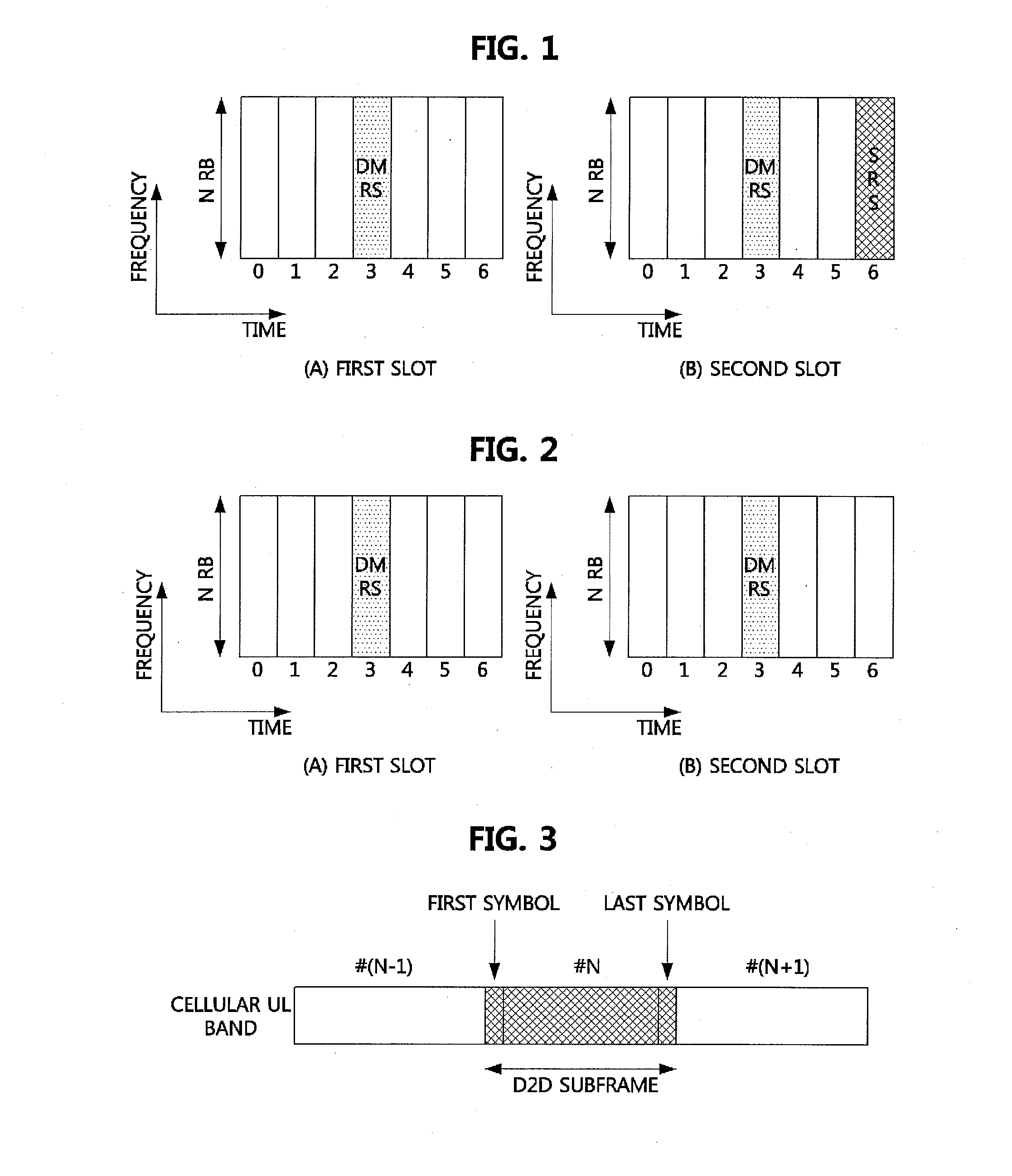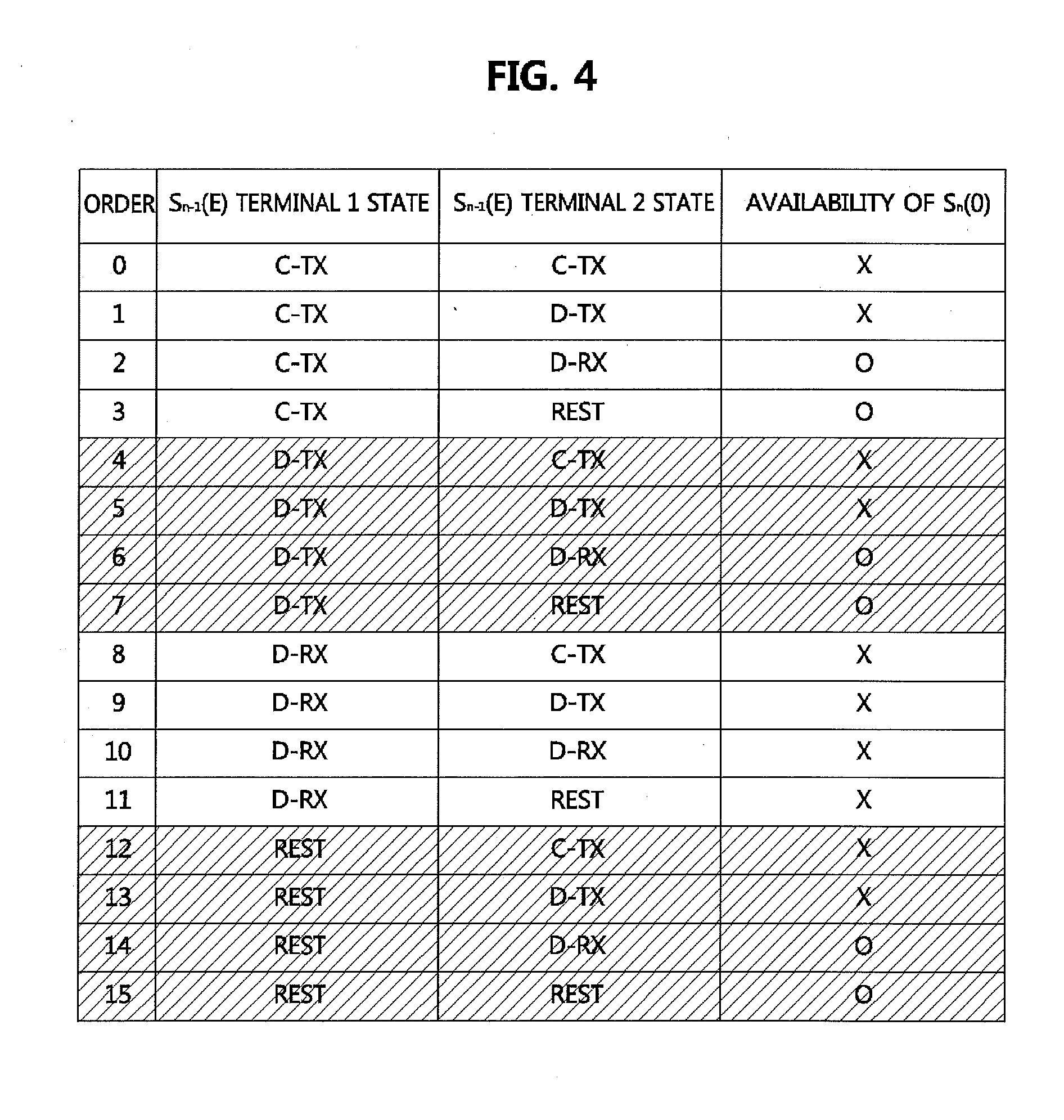Method of transceiving for device to device communication
a technology of device and communication channel, applied in the field of device to device communication, can solve the problems of not yet determined details of the cellular network-based d2d communication schem
- Summary
- Abstract
- Description
- Claims
- Application Information
AI Technical Summary
Benefits of technology
Problems solved by technology
Method used
Image
Examples
case 1
[0128](Case 1) Subframe (n−1) is not a Cell-Specific SRS Subframe
[0129]Case 1 corresponds to a case in which terminal 1 and terminal 2 are assumed to perform D2D communication with each other in subframe n, and subframe (n−1) is not one of cell-specific SRS subframes of terminal 1 and terminal 2.
[0130]FIG. 4 is a table showing whether transmission / reception for the first symbol of the subframe for D2D communication is possible according to a state of a terminal.
[0131]In the table of FIG. 4, a first column indicates order attached when transmission / reception for the first symbol of the subframe for D2D communication is possible. A second column indicates a state for the last symbol Sn−1(E) of subframe (n−1) of terminal 1 performing D2D transmission in subframe n. A third column shows a state for the last symbol Sn−1(E) of subframe (n−1) of terminal 2 performing D2D reception in subframe n. In this case, a fourth column in the table of FIG. 4 shows whether the first symbol Sn(0) of su...
case 2
[0134](Case 2) Subframe (n−1) is a Cell-Specific SRS Subframe
[0135]Case 2 corresponds to a case in which terminal 1 and terminal 2 are assumed to perform D2D communication with each other in subframe n and subframe (n−1) is one of cell-specific SRS subframes of the two terminals.
[0136]FIG. 5 is a table showing whether transmission / reception of the first symbol of the subframe for D2D communication is possible according to a state of terminal.
[0137]In the table of FIG. 5, a first column indicates order attached when transmission / reception for the first symbol of the subframe for D2D communication is possible. A second column indicates a state for the last symbol Sn−1(E) of subframe (n−1) of terminal 1 performing D2D transmission in subframe n. A third column shows a state for the last symbol Sn−1(E) of subframe (n−1) of terminal 2 performing D2D reception in subframe n. In this case, a fourth column in the table of FIG. 4 shows whether the first symbol Sn(0) of subframe n is availabl...
case 3
[0140](Case 3) Subframe n is not the Cell-Specific SRS Subframe
[0141]Case 3 corresponds to a case in which terminal 1 and terminal 2 are assumed to perform D2D communication with each other in subframe n, and subframe n is not one of cell-specific SRS subframes of terminal 1 and terminal 2
[0142]FIG. 6 is a table showing whether transmission / reception for the last symbol of the subframe for D2D communication is possible according to a state of a terminal.
[0143]In the table of FIG. 6, a first column indicates order attached when transmission / reception for the last symbol of the subframe for D2D communication is possible. A second column indicates a state for the first symbol Sn+1(0) of subframe (n+1) of terminal 1 performing D2D transmission in subframe n. A third column shows a state for the first symbol Sn+1(0) of subframe (n+1) of terminal 2 performing D2D reception in subframe n. In this case, a fourth column shows whether the last symbol Sn(E) of subframe n is available for D2D c...
PUM
 Login to View More
Login to View More Abstract
Description
Claims
Application Information
 Login to View More
Login to View More - R&D
- Intellectual Property
- Life Sciences
- Materials
- Tech Scout
- Unparalleled Data Quality
- Higher Quality Content
- 60% Fewer Hallucinations
Browse by: Latest US Patents, China's latest patents, Technical Efficacy Thesaurus, Application Domain, Technology Topic, Popular Technical Reports.
© 2025 PatSnap. All rights reserved.Legal|Privacy policy|Modern Slavery Act Transparency Statement|Sitemap|About US| Contact US: help@patsnap.com



